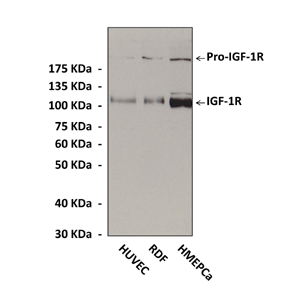Anti-IGF-1R: Polyclonal Insulin-Life Growth Factor Receptor Antibody |
 |
BACKGROUND The type 1 insulin-like growth factor receptor (IGF-1R) is a transmembrane tyrosine kinase. The mature IGF-1R consists of alpha and beta chains which are processed from a common precursor pro-IGF-1R. It is widely expressed among many cell types in fetal and postnatal tissues.1 Upon binding to its secreted growth factor ligands, IGF-1 and IGF-2, the receptors are activated and elicit a repertoire of cellular responses including proliferation and protection of cells from apoptosis.2 As a result, signaling through IGF-1R is the principal pathway responsible for somatic growth in fetal mammals, whereas somatic growth in postnatal animals is achieved through the synergistic interaction of growth hormone and the IGFs.3 Forced overexpression of IGF-1R results in the malignant transformation of cultured cells. Conversely, downregulation of IGF-1R levels can reverse the transformed phenotype of tumor cells, and may render them sensitive to apoptosis in vivo. Elevated levels of IGF-IR are observed in a variety of human tumor types, whereas epidemiological studies implicate the IGF-1 axis as a predisposing factor in the pathogenesis of human breast and prostate cancer. IGF-1R has thus emerged as a therapeutic target for the development of antitumor agents.4
REFERENCES
1. De Meyts, P. & Whittaker, J.: Nat Rev Drug Discov. 1:769-83, 2002.
2. Chitnis, M.M. et al: Clin Cancer Res. 14:6364-70, 2008.
3. Sandow, J.: Arch Physiol Biochem. 115:72-85, 2009.
4. Kim, S.Y. et al: Bull Cancer, 96:E52-60, 2009.
2. Chitnis, M.M. et al: Clin Cancer Res. 14:6364-70, 2008.
3. Sandow, J.: Arch Physiol Biochem. 115:72-85, 2009.
4. Kim, S.Y. et al: Bull Cancer, 96:E52-60, 2009.
Products are for research use only. They are not intended for human, animal, or diagnostic applications.
Параметры
Cat.No.: | CC1031 |
Antigen: | Sequence near the human IGF-1 R carboxyl terminal. |
Isotype: | Affinity purified rabbit IgG |
Species & predicted species cross- reactivity ( ): | Human, Mouse, Rat |
Applications & Suggested starting dilutions: | WB 1:1000 IP n/d IHC (Paraffin) n/d ICC n/d FACS n/d |
Predicted Molecular Weight of protein: | 97 kDa |
Specificity/Sensitivity: | This antibody detects endogenous human, mouse and rat IGF-1 receptors. |
Storage: | Store at 4° C for frequent use; at -20° C for at least one year. |
*Optimal working dilutions must be determined by end user.
Документы
Информация представлена исключительно в ознакомительных целях и ни при каких условиях не является публичной офертой








